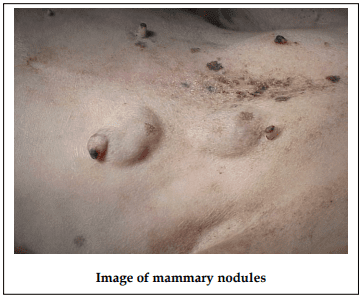Mammary Tumour
Masses within the mammary chain of animals can suggest serious mammary cancer and should be checked by your veterinarian when first noticed.
Clinical signs of mammary disease may include:
- Variable size of firm swelling(s), within the mammary chain.
- Evidence of bloody or fetid discharge from the mammary masses.
- Areas can be painful.
- Enlarged lymph nodes.
- Trouble breathing.
- Decreased ability to exercise.
- Coughing.
Cause of Disease:
The cause of mammary masses is unknown but generally linked to an animal’s heat cycle. The mammary tract is composed of duct tissue, connective tissue, and secretory tissue to produce milk. During each heat cycle the mammary tissue is stimulated for production of milk in case of pregnancy. In a course of your pet’s life this stimulation during heat cycles can promote the chance of mammary tumours. Masses can be benign or malignant. Masses can occur in spayed females, although less commonly. In males masses have been reported rarely. Mammary tumours are generally seen in animals over 5 years of age. Malignant mammary tumours do metastasize rapidly, typically going into the local lymph nodes and then into the lung fields.
Diagnosis:
There are other syndromes that can cause mammary nodules and swelling (e.g. Mastitis, mammary hyperplasia, lactation, other tumour types), so your veterinarian may suggest diagnostic tests to help determine the cause of the masses.
Diagnostic work:
- A complete blood count and chemistry will help your veterinarian to determine if there are any changes in the white blood cell count to suggest atypical white cells or a high number of white cells. It is also possible to identify infection, generalized bleeding, kidney disease, liver disease, pancreatitis and metabolic disease.
- Fine Needle Aspirate: These may be suggested to determine the cell type of the masses that lie in the mammary chain, or in the lymph nodes draining the mammary chain.
- X-rays: X-rays of the chest are important to ascertain if there are metastatic tumours evident.
Treatment:
The goal of treatment is to obtain tissue biopsy and potentially remove the cancer from the mammary tract. Excisions from mammary tumours are usually large to try to remove all presence of the tumour.
- Surgical removal and biopsy
- Medications: If your pet is diagnosed with mammary adenocarcinoma, there are chemotherapy drug protocols that may aid in remission of the cancer.
Please contact us immediately if:
- There is any weakness, lethargy, coughing or collapse.
- Your pet does not eat or drink.
- There is vomitting, diarrhoea, increased thirst or urination.
- Your pet begins to have severe discharge from the mass(es).
- There is any overall change in your pet’s health.

